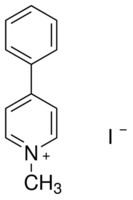Formula C12H12N+ | Molar mass 170.25 g/mol | |
 | ||
MPP+ (1-methyl-4-phenylpyridinium) is a positively charged molecule with chemical formula C12H12N+. It is toxic and acts by interfering with oxidative phosphorylation in mitochondria by inhibiting complex I, leading to the depletion of ATP and cell death. Mitochondria in cells treated with MPP+ also display a phenotype indicative of apoptosis: small, round, and fewer in number. It also inhibits the synthesis of catecholamines, reduces levels of dopamine and cardiac norepinephrine, and inactivates tyrosine hydroxylase.
The neurotoxin MPTP is converted in the brain into MPP+ by the enzyme MAO-B, causing parkinsonism in primates by killing certain dopamine-producing neurons in the substantia nigra. MPP+-induced neurodegeneration is specific to dopamine neurons and can be prevented by drug treatment or by limiting the function of the dopamine transporter.
The chloride salt of MPP+ has been used as a herbicide under the trade name cyperquat and is structurally similar to the herbicide paraquat.
In a rat model of Parkinson's disease, nobiletin, a flavonoid found in citrus, can rescue dopaminergic neurons from degeneration caused by treatment with MPP+.
